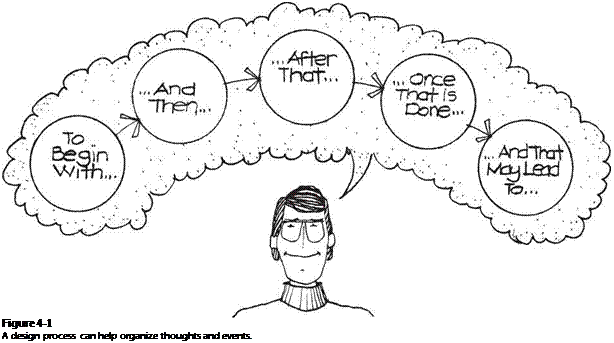INTRODUCTION
As suggested in Chapter 2, the residential site should be thought of as a series of outdoor rooms where people arrive, socialize, entertain, relax, recreate, eat, and work. These rooms are the basic framework of a well-designed residential site. To create these outdoor rooms, the landscape designer should utilize a sequence of problemsolving steps usually referred to as a design process. A design process, in one form or another, should be followed each time a designer engages in a new project because it aids in the organization of information and thoughts and helps in the creation of a suitable design solution for the given circumstances. This chapter identifies the importance of designing with a process and outlines the various steps involved. Later chapters explain many of these steps in greater detail.
DESIGN PROCESS
“What is a process?” A process may be defined as “a series of steps, actions, or operations used in making something or bringing about a desired result: a manufacturing process.” Similarly, it is “a series of actions, changes, etc., by which something passes from one condition to another: a lake in the process of drying up.”1 It can be seen that our world is filled with numerous processes. Natural processes include the development of a mountain range over centuries of time, the formation of a valley by means of erosion, photosynthesis, and the evolution of a butterfly from a caterpillar. Artificial processes include the manufacturing of a car, the sequence of events for formulating and passing a piece of legislation, the construction of a building, and the diagnosis of a medical ailment. Again, all these processes involve a series of steps or events that lead to a change or product.
A design process is similar. It can be defined as a sequence of problem-solving and creative steps used by the designer to develop an appropriate design solution for a given client and site. The designer uses this process from the beginning to the end of a design project as an organizational framework.
A design process is critical for three reasons. First, the design process helps to organize information and thoughts. It allows the designer to obtain the right information at the right time and to use it in making decisions (Figure 4—1). Second, the design process provides an orderly approach to solving problems at appropriate times
![]() The American Heritage Desk Dictionary (Boston: Houghton Mifflin Company, 1981), p. 754.
The American Heritage Desk Dictionary (Boston: Houghton Mifflin Company, 1981), p. 754.

that leads the designer to develop an appropriate solution for the unique needs of the client and the particular conditions of the site. Third, the design process helps the designer to explain reasons for the design solution to the clients. A designer who uses a process typically has an easier time explaining the end results.
For the layperson, the idea of a design process may seem somewhat complex. In fact, creating designs is not simple because design solutions don’t just happen by magic or fall out of thin air—although many people wish they did! On the other hand, everyone uses decision-making processes similar to the design process without realizing it to solve problems or plan events on a day-to-day basis. Such activities as getting dressed in the morning, buying a new car, cooking a meal, looking for a new place to live, or writing a paper all involve a series of steps that one must go through to solve the problem or complete the task at hand. These steps usually include analyzing the situation, defining the problem, developing ideas for solving the problem, selecting the best alternative, and then implementing the idea. As can be seen, we all use numerous processes in our lives. What is being suggested here is that the designer use a sequence of steps in creating a design solution for a residential site.
In residential site design, a logical design process includes the following major phases:
• Research and preparation
• Design
• Construction documentation
• Implementation
• Maintenance
• Evaluation
In one form or another, each of these phases is essential in the realization of quality residential site designs. Although the focus of this book is on the research and preparation phase and the design phase of the process, an overview of all phases of the process is necessary.



